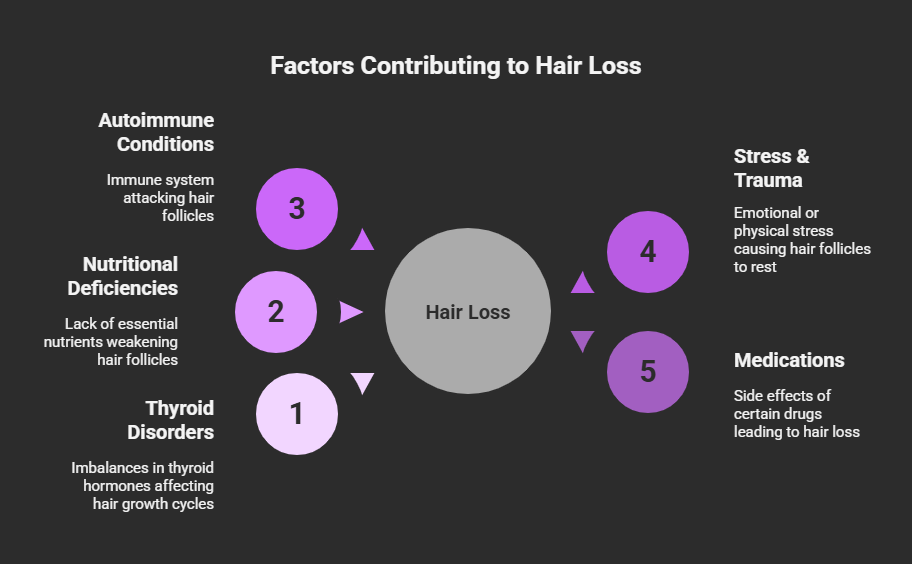Hair falling out. Frustrating. Scary, even. But, believe it or not, losing some strands every day is normal. The kicker? When that daily sprinkle of hair turns into a full-blown cascade, that’s your cue to pay attention. Who doesn’t want a full, healthy head of hair? Yet, for millions worldwide, it’s not about vanity, it’s about health. Alopecia. A word that carries weight, but also hope (yes, hope). Knowing when to see a doctor can make all the difference, kind of like spotting a small crack before the dam bursts.
What Is Alopecia?
Alopecia sounds like a fancy Greek thesis topic. But it’s simpler: it’s an umbrella term for hair loss. Sometimes patchy. Other times diffuse. (And yes, you’ll love this bit of trivia: “alopecia” literally means “fox mange,” since foxes can get hair loss too.)
Common Types of Alopecia
- Alopecia Areata: Sudden, patchy bald spots. Out-of-nowhere clumps of hair on your pillow.
- Androgenetic Alopecia: Also called male- or female-pattern baldness. Gradual thinning at the temples or crown.
- Alopecia Totalis: All head hair, gone.
- Alopecia Universalis: Every hair on your body, eyebrows, eyelashes, everything, disappears.
- Traction Alopecia: Caused by tight ponytails or braids (so, worth thinking twice about that daily topknot).
Normal Hair Loss vs. Red Flags
Funny thing is, we shed around 50–100 hairs a day. No biggie. Your scalp has about 100,000 follicles, losing some is like a city’s population ebb and flow. But when does that trickle become a flood? Here’s where we draw the line.
Normal Shedding
- Daily Brushes & Showers: A few strands in the drain.
- Seasonal Changes: More in spring and autumn. Nature’s reset button.
- Postpartum Loss: Hormones rebounding after pregnancy—hair says “see ya” in
Warning Signs
- Sudden, Noticeable Thinning: You run your fingers through your hair and feel more scalp than usual.
- Patchy Bald Spots: Circular or irregular patches on the scalp (sometimes itchy, sometimes tingling).
- Receding Hairline: More forehead showing in the mirror? A classic sign.
- Excessive Hair in Brush/Comb: More than the usual sprinkle.
- Hair Falling Out in Clumps: Not a few here and there, but fistfuls.
- Changes in Nails: Pitting, ridges, brittleness (odd connection, yes, it happens with alopecia areata).
- Scalp Irritation: Inflammation, redness, scaling. Could hint at an underlying condition.
- Family History: If your mom, dad, or siblings have pattern baldness (or an autoimmune history), you might be predisposed.
Why Early Diagnosis Matters
Here’s the lowdown: Catching alopecia early can open doors. Doors to treatments that might slow progression, or, in some cases, reverse it. Waiting? You risk deeper hairline retreats. Or even total loss of certain patches. And let’s not forget the emotional toll: anxiety, low self-esteem, that sinking “what if” feeling. See a doc sooner rather than later.
Hidden Culprits

Sometimes, hair loss comes hand-in-hand with other health issues:
- Thyroid Disorders: Hypo- or hyperthyroidism can throw hair-growth cycles out of whack.
- Nutritional Deficiencies: Iron, vitamin D, biotin, and vitamin B12. If you’re low, your follicles suffer.
- Autoimmune Conditions: Alopecia areata itself is autoimmune. Other conditions like lupus fit the bill, too.
- Stress & Trauma: Physical or emotional stress can shock follicles into a resting phase, telogen effluvium, to drop another fancy term.
- Medications: Chemotherapy? Blood thinners? Some drugs list hair loss as a side effect, read those labels.
When to Book That Appointment
Okay, you’ve spotted some red flags. Now what? Here’s a guide to knowing exactly when you should dial your doctor’s office, or click “book now” on that telehealth app.
1. Patches That Won’t Quit
By the time you notice, those round spots have already scooched across a few inches. If they don’t shrink in a month? Time to call.
2. Clumps in Your Hand
A few hairs are expected. But if your palm looks like a mini haystack, schedule that appointment. No ifs, ands, or buts.
3. Sudden, Total Shedding
You wake up, run a brush, and whoosh, drastic. That’s not normal, friend. Seek help, pronto.
4. Associated Symptoms
Itching, burning, scalp redness, nail changes? These often accompany alopecia areata. And if you’re seeing them, see a professional.
5. Emotional Toll
Under duress? Feeling down, anxious, and avoiding mirrors? Hair loss can chip away at mental well-being. You deserve support, medical and emotional.
What to Expect at Your Doctor’s Visit
Walking into that clinic, palms sweaty. But here’s the reassuring part: most dermatologists are hair-loss pros. They’ve seen it all. Here’s a peek behind the curtain.
Treatment Options: From A to Z
There isn’t a one-size-fits-all. Treatments pivot on your type of alopecia, its severity, and your personal preferences. Let’s spill the beans on some common ones.
Topical Therapies
- Minoxidil (Rogaine): Over-the-counter. Applied twice daily. Stimulates follicles (with a side of itching for some).
- Corticosteroid Creams/Gels: Anti-inflammatories to quiet autoimmune attacks.
- Anthralin: A tar-like paste that tweaks immune response, messy, but sometimes effective.
Oral Medications
- Corticosteroids (Prednisone): Systemic, for more severe cases. Watch out for side effects: weight gain, mood swings.
- Immunosuppressants: Methotrexate, cyclosporine, reserved for stubborn alopecia areata.
- Finasteride & Spironolactone: For androgenetic alopecia. (Women usually get spironolactone; men get finasteride.)
Procedural Treatments
- Corticosteroid Injections: Directly into bald patches, ouch, but might work like a charm.
- Platelet-Rich Plasma (PRP): Your own blood, spun down, injected back into the scalp. Science-y, but early studies show promise.
- Hair Transplant Surgery: For pattern baldness. Takes hair from one part of your head, plants it where it’s sparse. Expensive. Invasive. Yet lasting.
Alternative & Complementary Approaches
- Laser Therapy: Low-level lasers to stimulate follicles.
- Acupuncture & Traditional Medicine: Some swear by it (look, if it relaxes you, it can’t hurt, right?).
- Nutritional Supplements: Biotin, iron, and vitamin D, but only if tests show deficiencies.
Self-Care & Lifestyle Tweaks
Who says medical visits are the only answer? Small daily habits add up.
Gentle Hair Care
- Soft Brushes: No wire bristles.
- Loose Styles: Ditch the daily topknots.
- Cooler Styling Tools: Lower heat settings preserve hair integrity.
Diet & Nutrition
- Protein-Rich Foods: Eggs, fish, legumes. Hair is mostly protein.
- Iron Sources: Spinach, lean red meat, lentils (especially if you’re vegetarian).
- Omega-3s: Walnuts, flaxseeds, fatty fish. Nourish follicles from the inside out.
Stress Management
- Mindfulness & Meditation: Even five minutes a day can help.
- Exercise: Boosts circulation, to your scalp included.
- Support Groups: Online communities, safe havens to share fears, tips, triumphs.
Questions to Ask Your Doctor
Walking out with a head full of questions? Jot these down:
- “What type of alopecia do I have?”
- “Is my condition temporary or permanent?”
- “Which treatments do you recommend first?”
- “What are the risks and side effects?”
- “How long before I see results?”
- “Are there lifestyle changes I should make?”
- “Can we monitor progress with photos or measurements?”
Emotional Well-Being: The Hidden Battle
Hair loss isn’t just superficial. It hits confidence, self-image, sometimes harder than the follicles themselves.
Understanding the Impact
- Self-Esteem Dips: Feeling “less than.”
- Social Anxiety: Avoiding gatherings.
- Depression & Anxiety: When every mirror becomes an enemy.
Building Resilience
- Therapy: Cognitive behavioral therapy (CBT) can reframe negative thoughts.
- Mindset Shifts: Embrace what you can control, your attitude, and self-care routines.
- Community: Alopecia support groups (in-person or virtual) can remind you: you’re far from alone.
Real Stories, Real Hope
By the way, stories matter. Like Sarah’s. Diagnosed at 25 with alopecia areata, she tried creams, injections, and still saw bald spots. But after joining a support group, she found a dermatologist who recommended PRP. Six months later? New hair growth in places she thought were gone forever. Curious? That’s hope. And hope can be catalytic.
Key Takeaways
- Shedding vs. Alarm: A few hairs, normal. Clumps and patches, get them checked.
- Early Bird Advantage: Catching alopecia early broadens treatment options.
- Holistic Approach: Meds, procedures, lifestyle, all play a part.
- Emotional Health: Equally crucial. Seek support, share your journey.
Conclusion
Look, hair loss is more than a mirror reflection; it’s an experience. One that can shake your confidence, stir anxiety, and leave you feeling on the fence about what to do next. But here’s the silver lining: you’re not at the mercy of fate. Recognizing when to see a doctor, asking the right questions, and exploring treatments (medical and self-care alike) can shift the narrative. Imperfect perfection, embrace the journey, celebrate the small wins, and know that help is just an appointment away. Give it a try. Your future self, maybe with a fuller hairline, will thank you.








